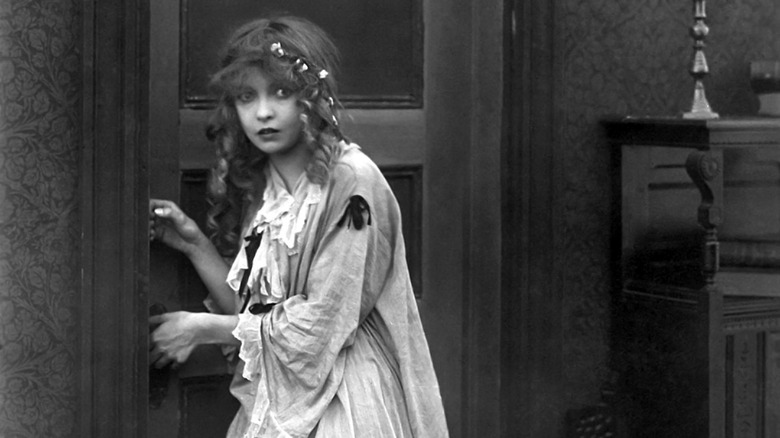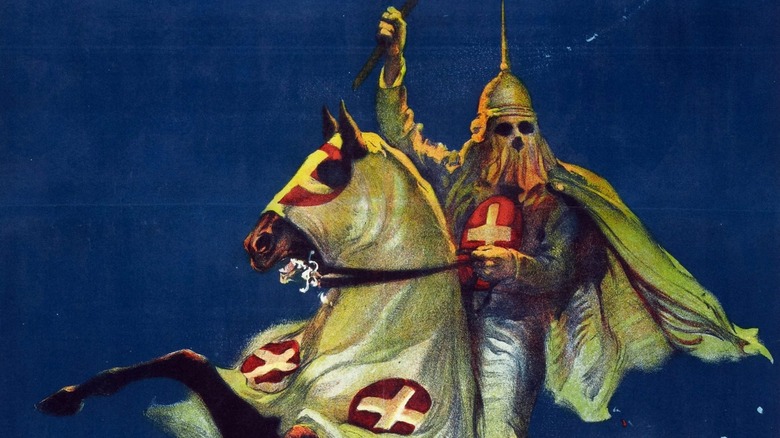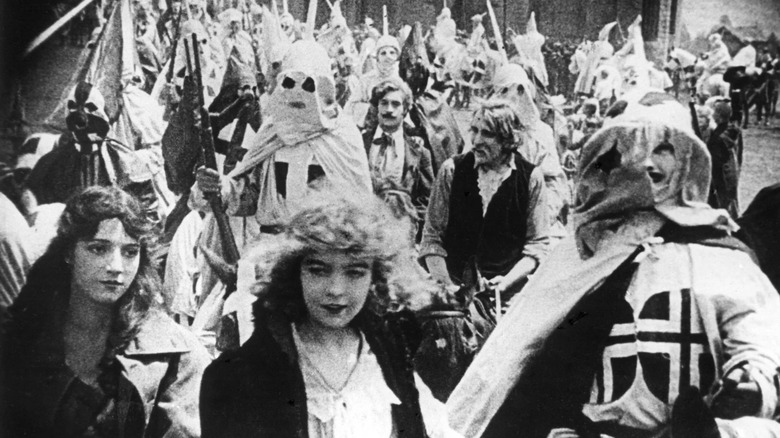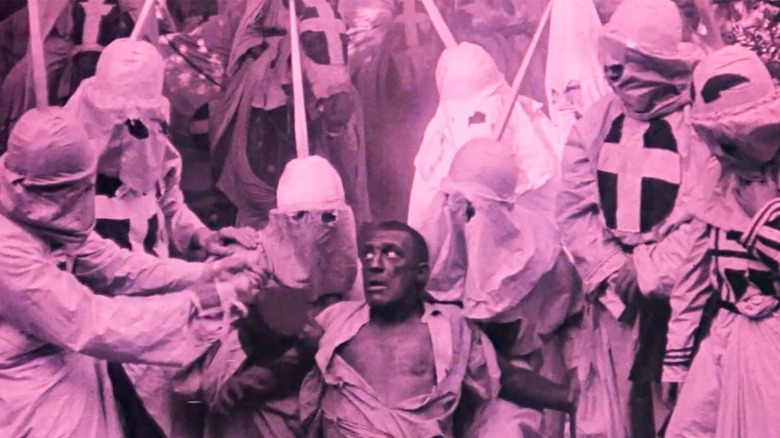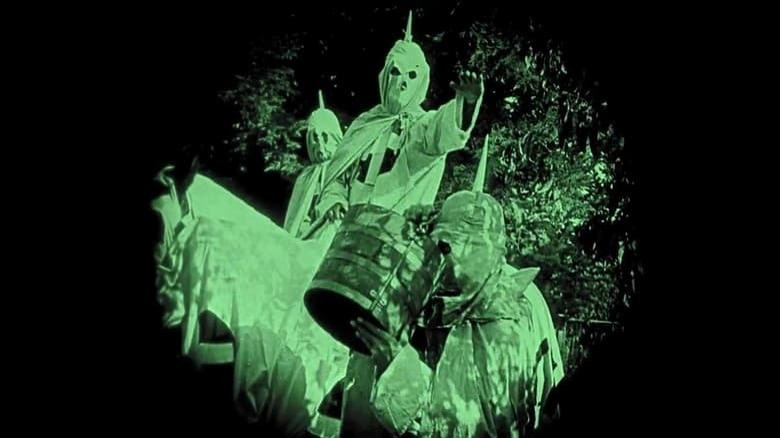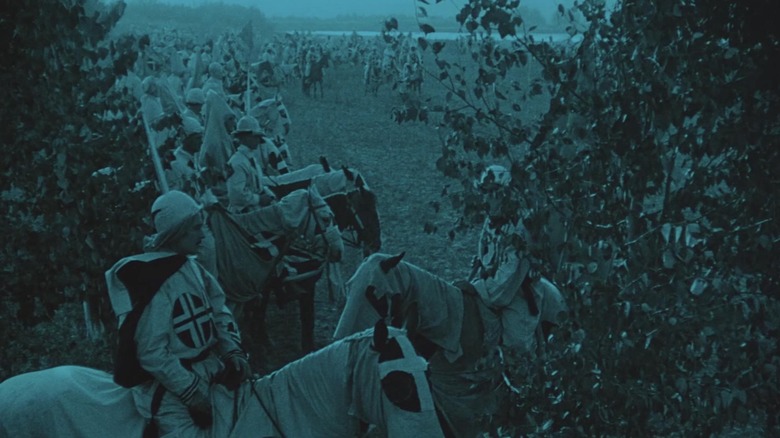The Birth Of A Nation Controversy Explained
We may receive a commission on purchases made from links.
The Ku Klux Klan was founded in Tennessee in December of 1865 by six former Confederate soldiers who were selling their new club as, seemingly innocently, a "fraternity." Borrowing the rituals and iconography from other "secret societies" that were booming in America after the Civil War, the founder claimed they were just having a few yuks. According to a 1907 encyclopedia of fraternities, the KKK's key interests were wholly innocent: "ludicrous initiations, the baffling of public curiosity, and the amusement for members were the only objects of the Klan." But, just like any underground organization of trolls — reflections in the modern age can be found in the slime pits of 8Chan — the irony quickly fell away, and the truly insidious, violent intentions of the Klan were soon made clear. By 1867, the Klan had grown to become several loose-knit groups of vigilantes (they did not wear white hoods yet) who sought to terrorize and murder anyone who stood in the way of a white supremacist ideology. The Klan targeted freed slaves, as well as politicians who fought for the rights of freed slaves, leaders from the North, and any Black person who became politically active.
The KKK's terrorism and hate found plenty of sympathetic members, but the group was ultimately attacked by the U.S. legal system as an aberration that had slipped through a legal crack. Federal laws were changed to stop the Klan, and protect the rights of Black people, as well as good Southern Republicans (bear in mind that, in the 1870s, Republicans and Democrats were ideologically opposite of what they are today). The KKK, as they existed then — that is, murdering vigilantes — were essentially shut down by 1871 (per U.S. House of Representatives). While white supremacist groups continued to promote their poisonous, hateful, anti-American ideas in the form of groups like the White League, the KKK was effectively dead.
That is, until 1915, when D.W. Griffith's "The Birth of a Nation" was released to the public, and the heroic mythologizing of the KKK was suddenly back in vogue.
America in 1915
Griffith's film is full of racist lies that a racist white public was eager to hear in 1915. While the United States had experienced an enormous economic boom at the turn of the century, and the nation appeared to be on the upswing in terms of technological innovation, sports, and science, by '15 a lot of the manufacturing jobs had dried up (per BLS) – the industrialization bubble had burst, essentially — and the unemployment rate had risen to nearly 10%. What's more, the bulk of the U.S. population was young, with over half of its citizens being under the age of 25, ostensibly leading to a general generation malaise. In times of economic upheaval, it's common to see white politicians deflect the failure of industry and the greed of corporations to an invading nonwhite "other," leading to a general suspicion of immigrants, Black people, and anyone the working white man can badger and blame.
Into this mix dropped "The Birth of a Nation," one of the grandest cinema projects yet put forth by a studio. At 193 minutes, it was the longest studio film made to date, and it employed most of the slickest film techniques of the time. The actual box office of "The Birth of a Nation" is unknown, however, and while you may have heard in your film classes that it was a hit, that may not necessarily be true. What we do know for certain is that white supremacy groups immediately latched onto "Birth," and began organizing screenings of it, stuffing the ballot box, as it were, and inflating whatever its earnings might have been. Some estimations have grosses in the $15 million range (via Time), making it the most successful film of all-time, only to be surpassed by "Gone with the Wind" in 1939 (another film that romanticized slavery and the post-war South).
Whether or not "The Birth of a Nation" was technically a hit, though, it did hook into racist impulses in white audiences, and encouraged the re-formation of the KKK.
The film itself
Based on the 1905 play "The Clansman" by Thomas Dixon, Jr., "The Birth of a Nation" is a turgid two-part melodrama that spans the Civil War from the perspective of a Union family and a Confederate family. Here, in a play on "Romeo and Juliet," the son of the Union family falls in love with the daughter of the Confederate family. There is a lot of battlefield footage, and a sequence where the Confederate women are rescued from a Black militia by a group of Confederate soldiers. The first part ends with Lincoln's assassination.
The second half spins wildly into racist imagery, depicting Black citizens as psychopaths who drink, are lascivious, cheat in elections, and actively deny white people voting rights. Griffith depicted the Black legislature in South Carolina as slovenly and obsessed with fried chicken. The Reconstructionist white characters, to fight back, dress as ghosts to form what is (in their minds) a superhero team. Lo, the modern image of the KKK was born. Eventually the Union character and the Confederate character team up against a common enemy: Black people. An actual intertitle from the film reads "The former enemies of North and South are united again in common defense of their Aryan birthright."
This s*** is unambiguous.
"The Birth of a Nation" climaxes with the Klan, hooded on horseback, rushing to the rescue of a white woman who is being attacked by a Black man. The Black characters, mind you, are played by white actors in blackface. The image of the poor white woman being threatened sexually by an encroaching Black attacker was (and is) a popular image used by racists. Indeed, there wasn't a racist stereotype, image, or notion that wasn't keyed into by the filmmakers: arguably, it's ground zero for the modern version of the US white supremacist movement. No wonder that the film was used as a recruitment tool for white supremacist groups. When Spike Lee featured "The Birth of a Nation" being viewed and cheered by the modern Klan in his 2018 film "BlacKkKlansman," he was drawing from reality.
What Birth of a Nation didn't do
There are many myths about "The Birth of a Nation" that have persisted in film schools for years. Each of these myths needs to be confronted. A list on the website Movies Silently was incredibly helpful in compiling the list below:
Myth #1: In "Birth of a Nation," D.W. Griffith invented the cinematic technique of cross-cutting — the editing practice of cutting between two scenes of action, using mutual rising activity to heighten tension in both scenes. This technique was already common by 1915, and was employed in the 1903 film "The Great Train Robbery." Indeed, Griffith even used the technique before in 1909 with a film called "A Corner in Wheat."
Myth #2: "Birth of a Nation" was the first feature film. Definitely no, and anyone who has seen silent movies knows this is an absurd claim. If we are to count any film over 40 minutes to be a feature (the current standard held by the Motion Picture Academy), then the first film was the 1906 Australian production "The Story of the Kelly Gang." It's not the first American feature either, as dozens of features preceded it, including three directed by Griffith.
Myth #3: "Birth of a Nation" was the first blockbuster, and Griffith was his day's Spielberg. Goodness sake, there were many blockbusters pre-1915. Need I bring up Auguste and Louis Lumière's 1896 film "L'arrivée d'un train en gare de La Ciotat?" It was only 50 seconds, but certainly caused a stir. Meanwhile, Georges Méliès' films were hits in the 1900s, and "From the Manger to the Cross," an film about Jesus Christ, was also huge.
Myth #4: It was the first film to be shown at the White House, viewed by president Woodrow Wilson. A record shows that the Italian film "Cabiria" was screened at the White House in August of 1914 (per Donna Kornhaber's "Silent Film"). But even if "Birth" had been the first film, it wasn't because Wilson was celebrating it. In a biography written by A. Scott Berg, Wilson was heard to criticize the movie by saying: "I have always felt that this was a very unfortunate production and I wish most sincerely that its production might have been avoided, particularly in communities where there are so many colored people." Wilson did not endorse the film and never said that it was "like writing history with lightning." That was mere false publicity. Additionally, one can actually look back to 1908 to see Teddy Roosevelt hosting documentary short films at the White House, so there is no credence to the vaunted "first film at the White House" myth.
The rebirth of the Klan
The popularity of "The Birth of a Nation" did, however, inspire a new generation to resurrect the Ku Klux Klan, this time in a more organized fashion. Adopting the costumes seen in the movie, this new Klan had expanded the post-Civil War group's goals of racism to include antisemitic, anti-Catholic, and "anti-American" rhetoric. Oh yes, and homophobia as well. Can't forget the homophobia. Much of what the revived Klan stood for aiming to conserve a more romantic period when straight white people were allowed to reign supreme.
This new Klan saw a boom in membership pretty quickly, with a lot of the Klan's rhetoric presented by Protestant ministers, many of whom were high-ranking officials in the organization. By the 1920s, Klan members were being elected into office, using fear of the Other, racism, nativism, and notions of white supremacy as their platform. The Klan became boosters of prohibition, spoke about the "sexual purity" of white women, and boosted infrastructure plans specifically to the detriment of Black and nonwhite communities. Some figures claim the KKK had anywhere from two-to-five million members in 1925 (per The Atlantic). And by the 1930s, Klan members had worked their way into high office.
The Great Depression would eventually pressure the Klan into disbanding for practical considerations, and the organization finally, loosely dissipated in 1944 ... 49 years after "The Birth of a Nation." It was in '44 that the IRS levied a tax liability against the KKK (per Loyola University). The organization would remain dormant ... for five years. The modern Klan opposed the Civil Rights movement (per History), and used anti-Black terrorism, imitating what was on the screen in "The Birth of a Nation." David Duke, a Louisiana politician, was Grand Wizard of the Klan from 1974 to 1980. He's still alive. He's 71. In 1995, Duke's ex-wife co-founded the website Stormfront which is still active to this day.
It's time to leave Birth of a Nation behind
The "fear of the other" campaigns started by the Klan way back in the 1870s, and codified and shocked back to life in 1915, may be the only really lasting legacy of "The Birth of a Nation." It was protested upon its release for its brazen racism, and director D.W. Griffith reportedly offered his next epic, 1916's "Intolerance: Love's Struggle Throughout the Ages," as an apologia. But the damage had been done, and no film was going to put the genie back in the bottle, so to speak. The language of the Klan had already been popularized, and the messages in the movie were offered as positive, comforting proof to white supremacists that they had a cause. "The Birth of a Nation" popularized dangerous, hateful speech to an enormous degree for the first time.
"The Birth of a Nation" is still considered an "important" movie by film schools, however. It was inducted into the Library of Congress in 1992, and it persists as a study object.
The film is reprehensible. It lies. Even if it contains a great deal of cinematic artistry, the monument that it has built feeds a dark toxic undercurrent of intolerance in American that needs to be wiped out. Its fearful storytelling and ignominious loathing of "the other" has fed into American politics for decades, and its suspicion of social progress still informs the speech of pundits to this very day. So, when modern bigots begin snorting over the word "woke," or complaining about the damage of immigrants, or whine that queer people exist, or pass legislation banning the teaching of the history of race in the United States, "The Birth of a Nation" is at the end of that string.
Perhaps this was the nation that was being born.
